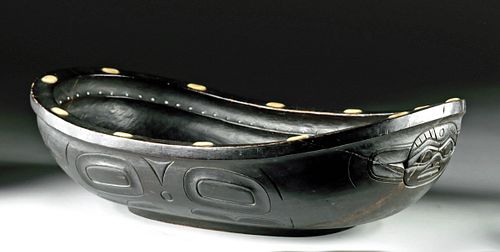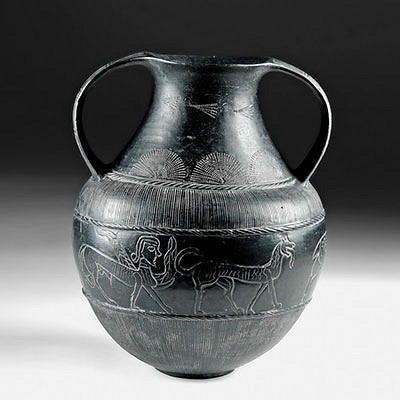Published 1919 Tlingit Wood Frog Bowl - Augustus Bean
Lot 120
About Seller
Artemis Gallery
686 S Taylor Ave, Ste 106
Louisville, CO 80027
United States
Selling antiquities, ancient and ethnographic art online since 1993, Artemis Gallery specializes in Classical Antiquities (Egyptian, Greek, Roman, Near Eastern), Asian, Pre-Columbian, African / Tribal / Oceanographic art. Our extensive inventory includes pottery, stone, metal, wood, glass and textil...Read more
Categories
Estimate:
$6,000 - $8,000
Absentee vs Live bid
Two ways to bid:
- Leave a max absentee bid and the platform will bid on your behalf up to your maximum bid during the live auction.
- Bid live during the auction and your bids will be submitted real-time to the auctioneer.
Bid Increments
| Price | Bid Increment |
|---|---|
| $0 | $25 |
| $300 | $50 |
| $1,000 | $100 |
| $2,000 | $250 |
| $5,000 | $500 |
| $10,000 | $1,000 |
| $20,000 | $2,500 |
| $50,000 | $5,000 |
| $100,000 | $10,000 |
| $200,000 | $20,000 |
About Auction
By Artemis Gallery
Sep 17, 2020
Set Reminder
2020-09-17 10:00:00
2020-09-17 10:00:00
America/New_York
Bidsquare
Bidsquare : CLEARANCE - Ancient, Pre-Columbian, Ethno Art
https://www.bidsquare.com/auctions/artemis-gallery/clearance---ancient-pre-columbian-ethno-art-5605
End-of-Summer Clearance sale featuring discounted pricing on antiquities from Egypt, Greece, Italy, and the Near East...plus Viking, Asian, Pre-Columbian, Tribal, Russian Icons, Spanish Colonial, Fine Art, more! Starting prices have been reduced up to 65% from original auction prices. Artemis Gallery info@artemisgallery.com
End-of-Summer Clearance sale featuring discounted pricing on antiquities from Egypt, Greece, Italy, and the Near East...plus Viking, Asian, Pre-Columbian, Tribal, Russian Icons, Spanish Colonial, Fine Art, more! Starting prices have been reduced up to 65% from original auction prices. Artemis Gallery info@artemisgallery.com
- Lot Description
**Originally Listed At $6000**
Augustus Bean (Tlingit, 1850-1926), inscribed "Sitka (Alaska) 1919" on bottom. An exceptional oval feast dish carved from wood and skillfully decorated with low relief carvings of two frogs on the interior, a zoomorphic face at each short end of the exterior, and larger-scaled abstract visages on each exterior side wall. Around the rim are 12 bean-shaped whale/sea mammal bone inlays, and there is a row of tiny white inlaid shell beads around the interior, about one inch below the rim. Bean was a Tlingit carver who trained at the Shelton Jackson School (later Museum) during the late 19th century and subsequently had a shop in Sitka, Alaska until the mid-1920's. Size: 18.375" W x 5.375" H (46.7 cm x 13.7 cm)
The frog is an animal of great importance in Northwest Coast art and culture. As an amphibian creature that lives in two worlds, in water and on land, the frog is revered for his remarkable flexibility and adaptability, his ability to traverse these worlds as well as to inhabit both the natural and supernatural realms. The frog is also believed to be the spirit helper of shamans. Given its vocal ability to croak, the frog is highly regarded as a great communicator, who represents the voice of the people. What's more, the frog's songs are believed to be magical, containing divine power. When shown in art as touching or sharing his tongue with another creature, the frog represents an exchange of knowledge and power.
The Tlingit have great respect for frogs, believing that these amphibian creatures bring good luck and fortune. The following legend is from the Cape Fox and Tongass Tlingit people. One day a young lady caught a glimpse of a frog in her path, and she made an insulting remark about frogs. The Tlingit took this as a serious offense that would lead to severe punishment. Soon after this event, the woman met a handsome man who proposed marriage to her. (In reality, he was actually a frog, but appeared to her as a young man.) She agreed to meet him at a lake in the woods a while later. He promised that he would take her to his home and introduce her to his father who was a chief. When they reached the edge of the lake, he asked her to step on a patch of water lilies; however, she was afraid until he demonstrated by stepping on them himself. They soon arrived in his village where he took her to his father's house. Unbeknownst to her, it was actually the frog's home beneath the lake.
Understanding that the young woman had offended the frogs, her relatives thought they would give a feast to honor them in the hopes that they would return her. They delivered an invitation to the lake and prepared the feast. As evening approached, they saw the young woman with two frogs, a large male and a small one - her husband and child - sitting on a marshy spot in the center of the lake, only they soon disappeared. Soon her relatives drained the lake to recover the young woman. She shared her story, but soon perished.
According to legend, those who live extremely devout lives may occasionally see the young woman rise from the middle of the lake. To achieve this, one must fast for many days and subscribe to strict taboos, and immense luck and great riches will come to anyone who succeeds. She is most likely to be seen when the sun shines upon the water, its rays bedazzling her gleaming long hair.
Exhibited at the Sheldon Jackson Museum in Sitka, Alaska. Published in the museum catalogue (p. 41, 1996).
Provenance: ex-Los Angeles, California, USA art dealer collection, acquired from the grandson of an Alaska sea captain who collected it in 1919 - Exhibited at the Sheldon Jackson Museum in Sitka, Alaska. Published in the museum catalogue (p. 41, 1996)
All items legal to buy/sell under U.S. Statute covering cultural patrimony Code 2600, CHAPTER 14, and are guaranteed to be as described or your money back.
A Certificate of Authenticity will accompany all winning bids.
We ship worldwide and handle all shipping in-house for your convenience.
#145819Slight surface wear. Professionally repaired from two large pieces with visible seam but very well done. Inscribed "Sitka (Alaska) 1919" on bottom.Condition
- Shipping Info
-
All shipping is handled in-house for your convenience. Your invoice from Artemis Gallery will include shipping calculation instructions. If in doubt, please inquire BEFORE bidding for estimated shipping costs for individual items.
-
- Buyer's Premium



 EUR
EUR CAD
CAD AUD
AUD GBP
GBP MXN
MXN HKD
HKD CNY
CNY MYR
MYR SEK
SEK SGD
SGD CHF
CHF THB
THB

















